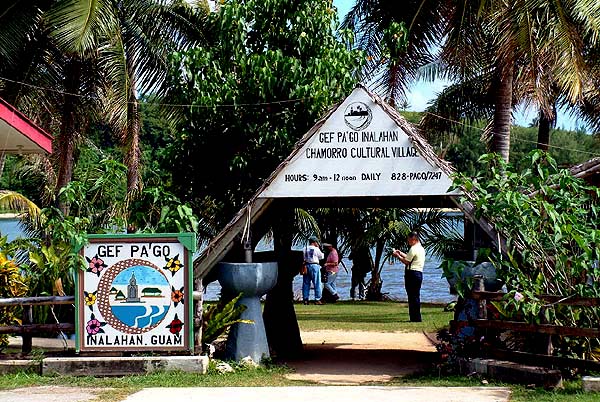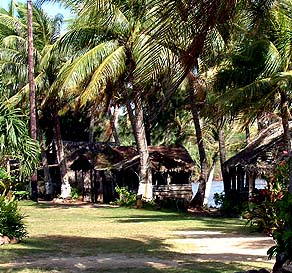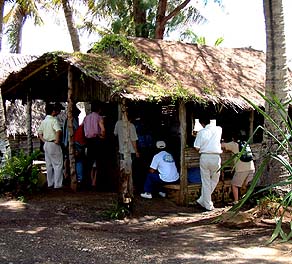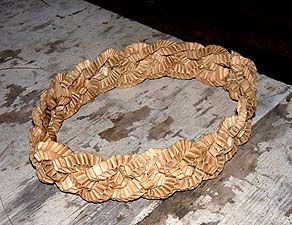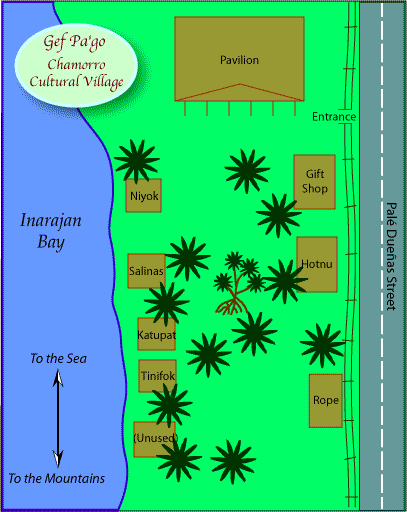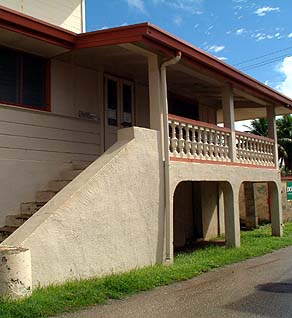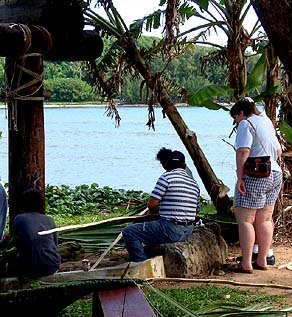 |
 |
 |
 |
||||
|
|
|
|
|
|
|
|
|
|
|
|||||||
|
|
|
|
The entrance to Gef Pa'go Chamorro Cultural Village.
|
|
|
“Gef Pa’go is a little Chamorro cultural village located on the shores of Inarajan bay, consisting of about eight thatched huts," Judy explained, "and we are a living museum that employs traditional crafters and folkways practitioners, to show tourists and to teach our local residents how it was. “There was a real cultural rupture, as you can probably imagine. Guam and the Marianas have been influenced by missionary or colonial influences since earlier than any of the other islands — earlier than Melanesia or Polynesia. So there has been a drastic change, but there are still elements of the culture that continue in modified forms. A lot of what you see of the folkways are adaptations from Spanish times. For example, the beehive oven — that’s from Mexico or Spain."
|
||
|
|
||
|
“I didn’t want to go back that far in history, but I did want people to see the way Chamorros lived in the first half of the 20th century — pre-war. Because the drastic change came after the war. So we have people who work here, who remember how life was before the war. Tan Floren, for example, grew up right across the street, and she can tell stories of how she grew up in that village, and that’s what we want. Something within memory. "Gef Pa'go was founded in 1992. When I was working for the Arts Council, I was able to get a planning grant from the Administration for Native Americans, and worked with the people of Inarajan, who were familiar with the concept because of Lanchon Antigo, which was an earlier version of this village. It was very successful for a while, but it was before its time, and there weren’t enough tourist numbers to support it."
|
|
|
|
"So that brought memories back, and the people of the village were receptive to it, and we were able to get this grant. We did a survey of what they wanted it to be, and followed their directives, and we’ve been struggling — this is our tenth year. With tourism ups and downs and things like that, and we are a non-profit organization, everything that we make goes back into the village, but depending on tourism numbers, we can make it or we can’t. And our employee numbers reflect our tourism numbers. "We’re trying to develop a volunteer base. We have a group of very loyal employees who spend a lot of time volunteering after hours. We can only afford to employ them for three hours a day, to meet the tour bus needs that come by. But if you came back in the afternoon, you would find some of them still working. So we do have a good employee-volunteer base, a labor of love, really."
|
|
"Gef Pa’go has summer camp next month (July)," Tan Floren adds, "and then in August again, and even adults, they’re welcome to come. Even they are teaching them how to weave the thatched roof. "The kids, they really want to learn, they’re very interested! When I tell them to go because it’s time for their lunch, they say ‘No, I’d rather stay.’ They don’t want to leave, they just want to continue weaving. They enjoyed the last time they were here, they don’t want to stop. "We get about 15 kids, they go from one hut to another. From coconut candy, coconut oil, even making tortillas, they grind it, so the kids will grind it and make tortillas, and they cook it. They make the headband, it’s easy for them to learn. Then after one or two weeks, they have a little party. And what they learn, they save it, take it home."
|
|
|
|
|
|
Interactive map: Click on the structures to learn more.
|
|
"Gef Pa'go is tourist-dependent. We get at least 10,000 school students a year. They come down on field trips, and that’s a very important part of our mission. We like to do hands-on projects with the school students, and we’ve developed a curriculum for almost all of the folkways and crafts that you see there. "So that if they make arrangements and bring down a small enough group, we have a curriculum sheet, say, for coconut leaf weaving, that we give to the teacher ahead of time, so they can work on the vocabulary, and how to gather the leaves, and things like that. And then when they get there, then we have the actual materials where they can actually learn. So we have that, but we also have large groups that can come through and observe. Then we usually have participatory games, traditional games for them to try."
|
||
|
|
||
|
"We’re not a destination, we’re a stop-by. And I would really like to make us a destination. We have a lot more to offer than the tourists actually see. The tourists are on their way around the island, or they’re on their way to Cocos Island, and we’re a stop-by, and they see the basic tour. We offer them six crafts and folkways demonstrations. "But we also have two historic homes that we have open for tours. One was built in 1902, and the other one was built in 1914. Both of them were built out of native limestone mortar and native woods. We’re a satellite for the Guam Humanities Council. And we have a small archive of documents, videos and reading materials from their archives. "We are starting to work with the local middle school. They want to start doing tutorials up there, and working with us, having their students shadow our crafters. Our focus, most recently, has been community outreach."
|
|
|
|
"Part of my vision is that Gef Pa’go doesn’t need to control all of the business, it doesn’t need to control everything, it just has to be the catalyst to help people, if they need grants to help improve these houses, fine. If we need to get our money back, we could operate it for a certain amount of time and then give it back to the families. "There are a lot of tourism destinations around here, Gef Pa’go could be a hub where main transportation from Tumon would come down and hopefully we would have all these things going on in the village that would support make it worthwhile for them to spend some hours here. "But then we’d also like to have further transportation, trolleys or something, that would take them to Southern Comfort Ranch, or the Jungle Tour at Talafofo, or even down to Setti Bay. They’re trying to recreate an ancient Chamorro village, and bring boat tours there. But it’s very small, and they’re struggling."
|
|
|
|
|
"This is the kind of thing we could promote through Gef Pa’go," Judy concludes."We could be a central place where they could take that tour as an optional tour. We’re not looking for a percentage, it's just the fact that we could help. All of us together have more strength, that we could help develop the South into something that all of us in the South want. And it’s been established that people in the South don’t want big hotels. "So let’s control it and take it where we want it to be."
An important component of community vitality in Inarajan continues to be the church, Inarajan's sacred site.
|
||
|
|
||
|
|
|
|
|
|

|
| Inarajan Home | Map Library | Site Map | Pacific Worlds Home |
|
|
|
|
|
|
|
|||
| Copyright 2003 Pacific Worlds & Associates • Usage Policy • Webmaster |
|||
